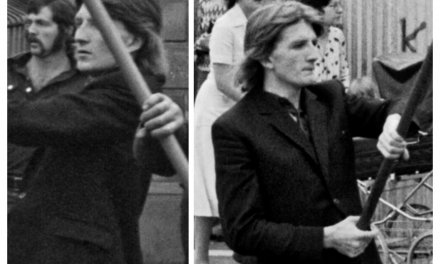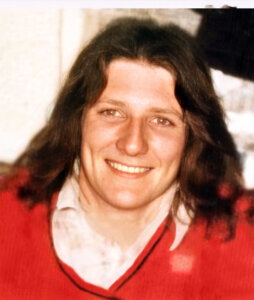 From The Guardian – Wednesday October 22, 2008
From The Guardian – Wednesday October 22, 2008
Held in the notorious Northern Irish jail in the 70s, Ronan Bennett recalls the gas attacks, the beatings, the smell – and the jokes – and applauds Steve McQueen’s haunting new film about its best-known inmate, IRA hunger striker Bobby Sands.
The sky was low and grey and the smoke from last night’s fires hung in the air. I was in the middle of the first football pitch. There was a lot of noise and movement and I didn’t know which way to run or what I was doing or what I was supposed to do. We had been drawn up in companies and squads, ready to fight back. But with the first of the gas communication had broken down completely. The helicopter banked again into position and the next canister was dropped. There was a small explosion in the air, perhaps 20 or 30 metres above us, as the canister splintered and the shower of bomblets announced themselves with an individual billow of white smoke, pushing gracefully out in all directions and hanging in the air for a moment like some vapoury spider before beginning their descent.
The panic gas induces temporarily overthrows everything you think you are, or hope you might be. It’s the violent desperation of a drowning man who will clutch at anything, even a child, even his own child. With gas, courage certainly goes. So does any sense of solidarity, the thing of which Long Kesh’s republican prisoners were so proud. When you are fighting for breath, tears streaming down your face, snot in your nostrils and bile in your mouth, it becomes every man for himself. The two football pitches in the middle of the vast prison complex were separated by a wire fence, in the midpoint of which was a gate the size of your front door. It was on this door that my attention was fixed. I wanted to get through it and into the other, gas-free, pitch. Unfortunately so did the hundreds of gasping, spewing, half-blinded men I was among. Passage was fiercely contested. Once through, respite was brief. The helicopter simply made the short hop and more canisters came down. Most of us had had experience of CS gas before prison, on civil rights marches or in riots. Later there were rumours that the soldiers had used the more potent CR variant, such was the reaction it brought in the men, though perhaps this was merely the result of a new intensity of saturation.
We headed in a wave back the way we came, through the door, shorter of breath, seeing less. The helicopter followed patiently, so did the gas, and we doubled back again. I can’t now recall how many times this happened, but I do remember towards the end stumbling over someone who had fallen in the scrum: he was calling for his mother. Some prisoners fought on, jabbing at the soldiers in their riot gear, batons and shields with broom handles and bits and pieces of whatever debris of the smouldering jail they could lay their hands on and hurl. They were a tough crew, but in the end they too surrendered. We were herded back to our cages and the beatings began.
One thing I’ve learned is that if you’re going to burn down a prison you should do it in the spring. This was October, 1974, and for the next few weeks we lived out in the open, or in crude, post-apocalypse shelters salvaged from the wreckage. Our hair grew and our beards sprouted. We hauled the covers from the manholes and crapped directly into the sewers. We probably didn’t smell very good, but when everyone smells bad you don’t notice so much. We wore grey blankets as ponchos, cutting a slit in the middle for our heads to go through. We huddled together against the cold and sang songs, told jokes and talked endlessly about politics and what the future might hold. Sometimes we just messed. One night a kind of collective and spontaneous silliness overtook our cage and a hundred grown men started playing tag and hide and seek. I was laughing so much I couldn’t run and was one of the first to be caught.
Gradually conditions improved and the rhythms of Long Kesh life re-established themselves: exercise and visits; court appearances and football; Irish classes and letters; reading and sexual frustration. Prisoners came and went, the repeating pattern of releases and arrests providing a constant turnover. Among those who walked through the gate to our cage was a softly spoken and quietly determined Derry man called Patsy O’Hara. Patsy had been shot by the British on a barricade in Derry, and it was not his first time in prison. He died five years later, on May 21 1981 after 61 days on hunger strike, at the age of 23. There was a scattering of ancient men in their 30s and 40s; veterans of previous campaigns, decrepit by our youthful harsh lights, but the men in Long Kesh and Crumlin Road and the women in Armagh jail were terribly, terribly young.
At some point – I don’t remember when – we noticed something ominous was happening. The prison was being rebuilt but differently. Workmen began blasting concrete from thick hoses on to cross-work spindles of steel. Instead of the wire cages and Nissen huts we lived in, walls were going up in a new phase of the jail’s expansion. Progress was very rapid. Simultaneously, the British government announced that the political status we enjoyed – tacit government recognition that what was happening in the north of Ireland was not some inexplicable outbreak of mass criminality but the result of a political crisis – was to be ended. Prisoners convicted after March 1 1976 would not join us in the cages. These prisoners would have cells. They would have uniforms. They would have walls. They would be locked up in the H-blocks and they would be criminals.
It says a lot about how little the British understood their republican enemy and how little they had absorbed of the lessons of Irish history that the government of the day – Harold Wilson’s – thought that all it would take to break the prisoners was to isolate them and force them into prison uniforms. A dozen or so cages, a hundred men to a cage, cannot be controlled, as the burning down of Long Kesh in October 1974 demonstrated. A single man in a cell can be intimidated and made biddable. This was the official thinking. But the state invariably underestimates the resolve and resourcefulness of politically motivated prisoners. A young republican called Kieran Nugent, the first to be convicted after the cut-off date for political status, was to show exactly how hopelessly naive British reasoning was. Nugent refused to wear the prison garb and became the first “blanketman”. He was soon joined by Jackie McMullan (Jackie and I had been in the same class at school). Over the coming months and years hundreds of prisoners went on the blanket. The blanketmen endured beatings and abuse and squalor. They escalated their protest by refusing to slop out: they tipped their urine under the cell doors into the corridor and smeared their walls with their own waste. The beatings continued. In 1981 they took their demands for the right not to wear prison clothing and the right to free association to the ultimate level: hunger strike.
I do not know that I have ever seen a film as powerful, beautiful, haunting and individual as Hunger, Steve McQueen’s movie about the dirty protest and the hunger strike. Obviously, having been in Long Kesh, some of the movie’s impact on me is particular, though I was never in the H-blocks (I was released, suddenly, before the blanket protest began). But as a writer I was, frankly, awed by McQueen’s art and vision, by writer Enda Walsh’s superb and unusual framing of the story, by Tom McCullagh’s stunning production design, and by the authenticity and breathtaking dedication that actor Michael Fassbender brought to the role of Bobby Sands, the leader of the hunger strike and the first to die, on May 5 1981, by which time, as well as being a convicted IRA prisoner, he was also MP for Fermanagh and South Tyrone.
With Hunger, McQueen and Walsh have thrown away the film-making rulebook. Eschewing explication, they have allowed what is implicit in each scene to emerge unforced and unstressed. The film’s producers and backers – Blast Films and the UK Film Council – must get credit here. Many, even most, producers would have insisted on the need for backstory. Who are these prisoners? What have they done? What do they want? Why are they smearing their own shit on the walls? What do they believe in? Are they good guys? Are they bad? What is their story?
McQueen and Walsh throw us as viewers in at the deep end, trusting that what we see will eventually make us understand. Instead they rely on McQueen’s powerful visual lyricism. One example: we cut to a man in the prison corridor. The character is unknown to us and does not appear again. He is in rubber boots and protective clothing. He wears a face mask. He sprays the urine-drenched floor with disinfectant then takes a squeegee and starts to push the piss-disinfectant mix in front of him, cleaning the corridor as he goes. There is no dialogue, we can see no expression on his face. After perhaps 10 or 20 seconds – in movie time that’s long – you think the director and editor will cut the scene. But they don’t. The man continues the whole length of the corridor, the light playing on the foul liquid running at his feet. In conventional movie wisdom if you can take a scene out and the movie still makes sense, it probably means that the scene isn’t necessary. In Hunger this long, wordless and unsettlingly beautiful moment is anything but redundant: you are made to think of how ordinary tasks – something as regular, methodical and quotidian as cleaning a floor – are contiguous with the most unimaginable horror: behind the doors the man with the squeegee passes are human beings living literally in shit.
If the squeegee scene is quiet and reflective, others are disturbing in the sheer verisimilitude of their violence (the only inauthentic aspect of the film is the block’s quietness and the absence of camaraderie). Rarely has a movie been more explicit in what it means to be punched and kicked and stamped on. The beatings meted out to the protesting prisoners are not highly stylised James Bond-like affairs. Each blow registers, its impact is felt, you shudder as contact is made. When I’ve talked to men who were on the blanket, one of the things they agree caused most stress was waiting for the moment the cell door would open and they would be dragged out, naked and defenceless, and then pounded into semi-consciousness before being thrown back in again.
Fuelling the prison officers’ anger was a mix of sectarianism – they were almost exclusively protestant and many had loyalist sympathies and connections – and a desire for revenge. They were also venting their rage at having to work in such conditions. In Hunger Stuart Graham plays the fictional guard Ray Lohan, angst-ridden, taut and violent. At the start of the movie we see him rising for breakfast. He eats well, in ironic prefiguration of the starvation to come. He is sleek and groomed, but his knuckles are scarred and scabbed from the blows he has landed. Every morning he performs the ritual that he and his colleagues have come to regard as second nature: he checks his car for booby-trap devices (over the course of the protests and hunger strikes the IRA killed some 18 prison officers). Lohan may have power in the prison, but his own life hangs precariously.
Hunger’s central figure is Bobby Sands. Sands probably did more to turn the tide of the republican struggle than any other individual. His death garnered worldwide attention and sympathy, and it marked the beginning of the long run of electoral successes that eventually propelled Sinn Fein into government. Michael Fassbender’s dedication to his craft in losing so much weight to make his body look like that of a man who has been without food for two months has already received a great deal of praise. But the actor’s real achievement is in his reproduction of Sands’ unsentimental idealism, resilience and determination. “A big engine” is how he is described by Liam Cunningham playing Father Moran (based on Father Denis Faul, the worldly, canny country priest who was first admired by republican prisoners but fell into disfavour after he condemned the movement for, as he saw it, manipulating the hunger strikers). The scene between Sands and Moran comes more or less in the middle of the film, when Sands has announced his intention to go on hunger strike and die if necessary. It’s as unexpected as the squeegee scene. A two-shot lasting 20 minutes or more, two intelligent men with wary mutual respect, but with opposing moral and political standpoints, squaring up, jabbing, neither able to land the knockout blow, the sadness of what will shortly unfold hanging over them (Walsh’s dialogue here is pitch perfect). Everyone who knew Sands understood that when he went on hunger strike he would go all the way. Moran is talking to a dead man.
Hunger marks a significant break in cinema’s treatment of the Troubles. For all their considerable craft and individual artistic merits, movies such as Thaddeus O’Sullivan’s Nothing Personal (1995) and Jim Sheridan’s The Boxer (1997) were more conventional fare. Focusing on the violence inflicted by republican and loyalist organisations, treating both as essentially apolitical and gangsterish, individual members were depicted as bullying cowards, inadequates, psychopaths, terminally moronic or as wanting out. Questions of political as opposed to personal motivation go unexplored. (You do not have to have republican or loyalist sympathies to understand the artistic limitations of such an approach.) With Hunger, the film-makers make no explicit judgment of Sands. But in allowing him to emerge undiminished in body or spirit from the repeated rounds of assault by his guards and from his confrontation with Moran, and by giving his death such poignant resonance, Sands is allowed to achieve what few IRA movie characters have been permitted: the simple recognition of his full, complex humanity. Here the critical difference is that the emphasis is on the state as the perpetrator of violence and on republicans as the victims, something the 100,000 people who lined Sands’ funeral route would have had no trouble in recognising.
By the time of the events depicted in Hunger I had been released from a second spell of imprisonment, but my life was starting to run on new and different lines. I was at university, studying history, and I had not been home to Belfast for some time. I returned in 1982 and found a friend from the cages. Over a drink he told me that he’d recently talked to people who’d been in with Patsy O’Hara, the young but ferociously determined Derry lad I’d briefly known after the fire. According to their account, they helped Patsy into a shower stall and set him down on a chair because he was too weak to stand. Underneath the flowing water they thought they saw tears in his eyes. Nobody said anything. They dried him off, got him into his clothes and back to bed. My friend and I didn’t know if the story was true, and there may even be some who in their cups might object to the idea of a hunger striker crying because death is imminent and real. Sands sheds no tears in Hunger but the audience I saw the film with was profoundly moved. You will certainly see movies that you may enjoy more, but you will not see one as important or original as Hunger.



